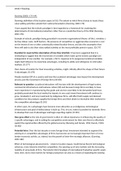Week 4 Reading:
Dunning (2001) 173-190:
Dunnings definition of the location aspect of OLI: The extent to which firms choose to locate these
value-adding activities outside their national boundaries (Dunning, 2001:176)
I have argued that the eclectic paradigm is best regarded as a framework for analysing the
determinants of international production rather than as a predictive theory of the MNE (Dunning,
2001:176)
Example of eclectic paradigm being grounded in economic organisational theory: all the L variables ±
be they labour costs, tariff barriers, the presence of competitors or agglomerative economics ± rest
on the tenets of one or other contextually related location theory, and also the assumption that
firms will seek to site their value-added activities at the most profitable points in space. (D:177)
Essential for exam Q/Nice description of how they interlink: It has been suggested that it is
misleading to suggest that the triumvirate of variables which make up the eclectic paradigm are
independent of one another. For example, a firm’s response to its exogenous locational variables
might itself influence its ownership advantages, including its ability and willingness to internalise
markets. (D:177)
their choice of location for their innovating activities, might critically affect the shape of their future
O advantages. (D:178)
Maybe mention IDP of a country and how the Locational advantages may impact this development
process and the investment of foreign firms (ID 181)
Relevant to question: Locational attractions will increase with the development of legal system,
commercial infrastructure and business culture (ID) and because foreign firms are likely to have
more experience in manufacturing the goods and services now likely to be demanded (and have
probably penetrated the local market by imports in any case) inward investment will continue to
grow. Gradually it, and any investment by indigenous firms, will affect both supply and demand
conditions for the products supplied by foreign firms and their desire to internalise their markets for
the competitive advantages (D:181)
In other cases, its L advantages have become more attractive as an indigenous technological
infrastructure and pool of skilled labour is built up. This, in turn, makes it possible for domestic firms
to develop their own O advantages and begin exporting capital. (D:181)
How govs effect L: the role of government is often of critical importance in influencing the quality of
L-specific advantages; and in setting the competitive environment for their own firms to effectively
exploit the opportunities offered by the global economy (Dunning and Narula, 1996; Narula, 1996).
(D:182)
Potential intro: Over the last decade or more foreign direct investment intended to augment the
existing O or competitive advantages of firms has become an increasingly important form of cross-
border economic activity, as, indeed, has the growth of inter-firm strategic alliances. (Dunning,
2001:182)
Effect of technological advancements – relate to location (Japan, South Korea) Recent technological
advances, more intensive interfirm competition, the opening up of new markets and the increasing
mobility of some kinds of firm- The Eclectic (OLI) Paradigm of International Production specific assets
have, then, led to new motives for foreign production not only as a means of exploiting the existing





